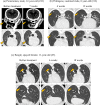PD-L1 immunohistochemistry for canine cancers and clinical benefit of anti-PD-L1 antibody in dogs with pulmonary metastatic oral malignant melanoma
- PMID: 33580183
- PMCID: PMC7881100
- DOI: 10.1038/s41698-021-00147-6
PD-L1 immunohistochemistry for canine cancers and clinical benefit of anti-PD-L1 antibody in dogs with pulmonary metastatic oral malignant melanoma
Abstract
Immunotherapy targeting programmed cell death 1 (PD-1) and PD-ligand 1 (PD-L1) represents promising treatments for human cancers. Our previous studies demonstrated PD-L1 overexpression in some canine cancers, and suggested the therapeutic potential of a canine chimeric anti-PD-L1 monoclonal antibody (c4G12). However, such evidence is scarce, limiting the clinical application in dogs. In the present report, canine PD-L1 expression was assessed in various cancer types, using a new anti-PD-L1 mAb, 6C11-3A11, and the safety and efficacy of c4G12 were explored in 29 dogs with pulmonary metastatic oral malignant melanoma (OMM). PD-L1 expression was detected in most canine malignant cancers including OMM, and survival was significantly longer in the c4G12 treatment group (median 143 days) when compared to a historical control group (n = 15, median 54 days). In dogs with measurable disease (n = 13), one dog (7.7%) experienced a complete response. Treatment-related adverse events of any grade were observed in 15 dogs (51.7%). Here we show that PD-L1 is a promising target for cancer immunotherapy in dogs, and dogs could be a useful large animal model for human cancer research.
Conflict of interest statement
Authors S.Y., K.Y., and M.T. were employed by Fuso Pharmaceutical Industries, Ltd. S. Konnai, K.O., S.M., Y.S., C.N., T.O., N.M., S.T., and Y. Kagawa are the authors of patent applications covering materials and techniques described in this paper (PCT/JP2017/029055, PCT/JP2018/11895). All other authors declare no competing interests.
Figures



References
LinkOut - more resources
Full Text Sources
Other Literature Sources
Research Materials

